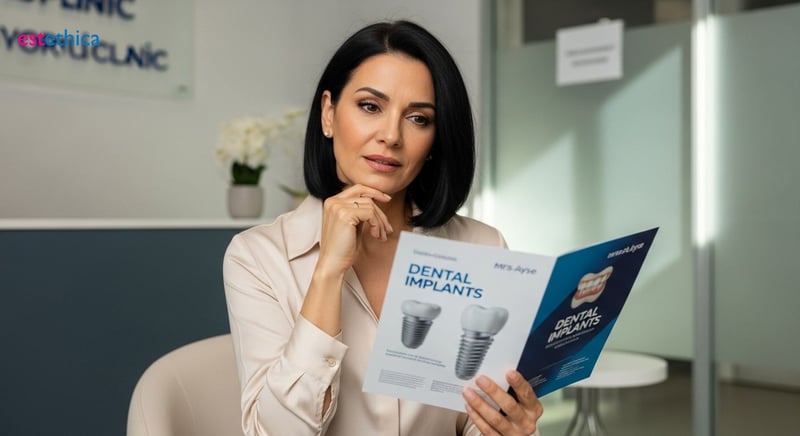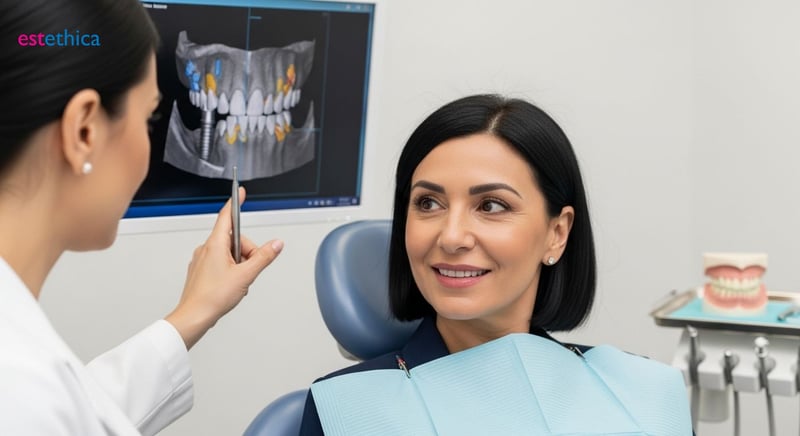Renew Your Smile with Modern Dental Implants
Discover how dental implants can restore your smile and oral health, covering the procedure, cost, comparison to bridges, and recovery essentials.
Understanding the Dental Implant Procedure: Step-by-Step Guide
Embarking on the journey to restore your smile with dental implants involves a well-defined process designed for optimal results and patient comfort. This comprehensive approach ensures that your new smile is not only aesthetically pleasing but also functionally robust. For those seeking a permanent solution to missing teeth, understanding each stage is crucial.
Initial Consultation and Treatment Planning
The first pivotal step typically involves a thorough consultation with your implant dentistry specialist. During this vital visit, they will meticulously assess your overall oral health, conduct detailed examinations using X-rays and potentially advanced CT scans, and review your medical history. This comprehensive evaluation is essential to determine your suitability for the procedure. Following this assessment, a personalized treatment plan is meticulously crafted, outlining every aspect of your journey. This phase is also an excellent opportunity to ask any questions you may have and to gain a deeper understanding of the benefits and process, perhaps by exploring resources like All About Dental Implants: Your Guide to a Confident Smile.
Surgical Placement and Osseointegration
The next critical phase is the surgical placement of the dental implant itself. This procedure involves the careful insertion of a small, screw-like post, commonly made from biocompatible titanium, directly into the jawbone where a tooth has been lost. This titanium post serves as a robust artificial tooth root. For many patients, this is a straightforward procedure performed under local anesthesia, with sedation options often available to enhance comfort and reduce anxiety. The cornerstone of successful implant dentistry lies in a remarkable biological process known as osseointegration. Over several months, your jawbone gradually fuses with the titanium implant, creating an exceptionally stable and permanent foundation. This integration is paramount for the long-term success of your new tooth. After sufficient healing and integration, a minor procedure is performed to carefully expose the top portion of the implant. An abutment, a precisely designed connector piece, is then securely attached to the implant. This abutment will ultimately serve as the foundational base for your new artificial tooth, ensuring a seamless transition.
Restoration with a Custom Crown
The final stage involves the placement of a custom-made crown. This prosthetic tooth is meticulously designed by skilled dental technicians to perfectly match the color, shape, and size of your existing natural teeth, ensuring a harmonious and lifelike appearance. Once ready, the crown is securely fixed onto the abutment. The culmination of this process results in a fully restored tooth that looks, feels, and functions just like your own. This remarkable achievement in modern implant dentistry represents a significant advancement in restorative and cosmetic dental care, offering a durable and aesthetically superior solution for missing teeth. The expertise of implant dentistry ensures a natural-looking and highly functional outcome.

Cost of Dental Implants: Investing in Your Oral Health
Understanding the financial aspect of dental implants is a significant consideration for many individuals contemplating this transformative treatment. The investment in dental implants extends beyond mere aesthetics; it represents a long-term commitment to revitalizing oral function, averting further dental complications, and enhancing your overall well-being. The total expenditure for implant dentistry can fluctuate based on a variety of elements, including the number of implants required, the intricate nature of the case, the specific types of implant and crown selected, and the geographic location of the dental practice.
Factors Influencing the Overall Investment
Generally, the cost encompasses the surgical placement of the implant post, the abutment that connects the post to the restoration, and the custom-fabricated crown that mimics a natural tooth. Ancillary procedures, such as bone grafting or sinus lifts – which might be necessary if you have insufficient bone density for successful integration – will also contribute to the overall expense. It is essential to view dental implants as a strategic investment in your health. Unlike traditional bridges or dentures, which may require periodic replacement over time, dental implants are engineered to provide a lifetime solution with diligent care, often proving more cost-effective in the long run. This enduring quality contributes significantly to their value proposition.
Making an Informed Decision
When you think about the long-term benefits and durability, the initial cost of implant dentistry becomes a more manageable perspective. For those exploring their options for replacing missing teeth, understanding the comprehensive nature of this procedure is key. You can learn more about how these restorations can help you Dental Implants: Restore Your Smile and Confidence. Many dental providers offer flexible financing options or payment plans to make implant dentistry more accessible to a wider range of patients. We strongly advise scheduling a thorough consultation with your dental professional. This consultation will provide you with a detailed breakdown of the estimated costs specifically tailored to your unique dental needs, enabling you to plan effectively and make a well-informed decision about investing in your smile with dental implants. The journey towards a restored smile and improved oral health begins with understanding all aspects of the treatment, including the financial commitment involved in achieving optimal results through teeth implants.
Dental Implants vs. Bridges: Making the Right Choice for You
When faced with the decision of replacing missing teeth, dental professionals often present two primary solutions: traditional bridges and modern dental implants. While bridges have long been a reliable option, the advancements in implant dentistry offer significant advantages that often make them the superior choice for many individuals seeking a durable and aesthetically pleasing restoration. Understanding the fundamental differences between these two options is crucial for making an informed decision about your oral health and the long-term future of your smile.
Understanding the Key Differences
The core distinction lies in how each restoration is supported. A traditional dental bridge requires the healthy teeth adjacent to the gap to be significantly altered. These supporting teeth are often ground down to accommodate crowns, which then anchor the prosthetic tooth. This process, while effective, compromises the integrity of otherwise healthy dentition, making them more vulnerable to decay, nerve issues, and other complications down the line. Furthermore, bridges do not address the underlying issue of bone loss that occurs when a tooth is missing. The jawbone in that area gradually deteriorates, which can affect facial structure and the stability of the bridge itself over time. This lack of bone stimulation is a critical drawback.
In stark contrast, dental implants are designed to mimic the natural tooth root. A titanium post is surgically placed directly into the jawbone, providing a robust foundation. This process, known as osseointegration, allows the implant to fuse with the bone, creating unparalleled stability. Crucially, this stimulation of the jawbone prevents bone resorption and helps maintain facial contours, preserving your natural appearance. This conservative approach means neighboring teeth are left untouched, safeguarding their health and structure. For those looking to truly restore function and aesthetics, exploring options through Transform Your Smile: Modern Cosmetic Dentistry can illuminate the potential of advanced restorative care, including the benefits of dental implants.
A Comparative Look at Longevity and Impact
While the initial investment for dental implants might appear higher than for a bridge, their long-term benefits are substantial. The ability of dental implants to preserve jawbone and prevent damage to adjacent teeth contributes to a more stable and enduring oral health solution. This translates to a potentially longer lifespan for the restoration and fewer complications over the years. The stability offered by teeth implants also allows for a more natural biting and chewing experience, enhancing overall quality of life. Bridging the gap in your smile with a solution that supports your natural bone structure is a key consideration.
Ultimately, the choice between bridges and teeth implants depends on individual circumstances, including oral health status, bone density, and personal preferences. A comprehensive consultation with your dentist is essential to determine the most suitable option for your unique needs and long-term smile goals. This discussion will encompass the nuances of implant dentistry and how it can provide a superior solution compared to traditional methods.

Recovering from Implant Dentistry: Tips for a Smooth Healing Process
The journey to a renewed smile doesn't end with the placement of your new dental implants; the recovery period is a critical phase that ensures the long-term success of your treatment. While individual healing experiences vary, adhering strictly to your dentist's post-operative instructions is paramount. In the immediate aftermath of the procedure, you may experience mild discomfort, swelling, or bruising. These symptoms are typically manageable with prescribed pain medication and by applying ice packs externally to the affected area for short intervals.
Maintaining Oral Hygiene and Dietary Considerations
During the healing phase of implant dentistry, maintaining impeccable oral hygiene is crucial. Your dentist will provide specific guidance on how to gently clean the implant site. This often involves using a soft-bristled toothbrush to carefully navigate around the implant and a mild antiseptic mouthwash. It's essential to avoid vigorous brushing or rinsing, as this can disrupt the delicate healing process and compromise the implant's stability. Regarding your diet, it's generally recommended to stick to soft foods and liquids for the first few days. This minimizes any pressure on the surgical site. As your healing progresses, you can gradually reintroduce a more varied diet. For those seeking to enhance their smile's appearance while waiting for implants to fully integrate, or as an alternative for other dental concerns, exploring options like Transform Your Smile with Dental Veneers can be beneficial.
Rest, Activity, and Follow-Up
Adequate rest is another cornerstone of a smooth recovery. In the initial days following your procedure, it's advisable to avoid strenuous activities and excessive physical exertion. This allows your body to focus its energy on healing. Your dental team will schedule regular follow-up appointments to monitor your progress. These visits are vital for ensuring that osseointegration – the process where the implant fuses with your jawbone – is proceeding as expected. Open and honest communication with your dental team is key throughout this period. Don't hesitate to reach out with any questions or concerns you may have. By diligently following these guidelines and maintaining close contact with your clinicians, you can facilitate a comfortable recovery and pave the way for the lasting aesthetic and functional benefits of your dental implants.

Mastering Dental Implant Procedures: A Step-by-Step Guide to Smile Restoration
Our comprehensive approach to implant dentistry begins with a detailed initial consultation and meticulous treatment planning. This ensures every aspect of your journey, from understanding the dental implant procedure to achieving optimal results, is tailored to your unique needs.
We expertly guide you through the surgical placement of titanium implants, focusing on achieving stable osseointegration, the critical process where the implant fuses with your jawbone. This foundational step is paramount for the long-term success of your new smile.
With a deep understanding of implant dentistry, we provide detailed insights into how dental implants work, addressing patient concerns about their safety and efficacy. Our expertise ensures you are well-informed about every stage, including the technical aspects like bone grafting when necessary.
We are dedicated to showcasing the transformative power of dental implants through before-and-after examples, illustrating the significant improvements in both aesthetics and oral health restoration. Our knowledge extends to explaining the nuances of different implant types and their benefits.
Ensuring a Smooth Healing Process and Optimal Results with Advanced Implant Dentistry
Our trust is earned through a commitment to patient well-being, offering guidance on rest, activity, and crucial follow-up appointments during the implant recovery phase. We ensure you feel supported throughout your smile transformation.
We address common questions, such as "What are the alternatives to dental implants?" by thoroughly discussing options like dental bridges, while emphasizing the unique benefits of implants as a long-term dental solution. Our goal is to build confidence in the chosen treatment path.
Our expertise covers the latest advancements, including the discussion of materials like Zirconia dental implants and techniques for same-day dental implants. We also explain the benefits of mini dental implants for specific cases.
By detailing the entire process, from initial consultation to the placement of a custom dental crown, we build trust and ensure patients understand the journey towards restoring their oral health. We focus on delivering results that significantly improve quality of life.